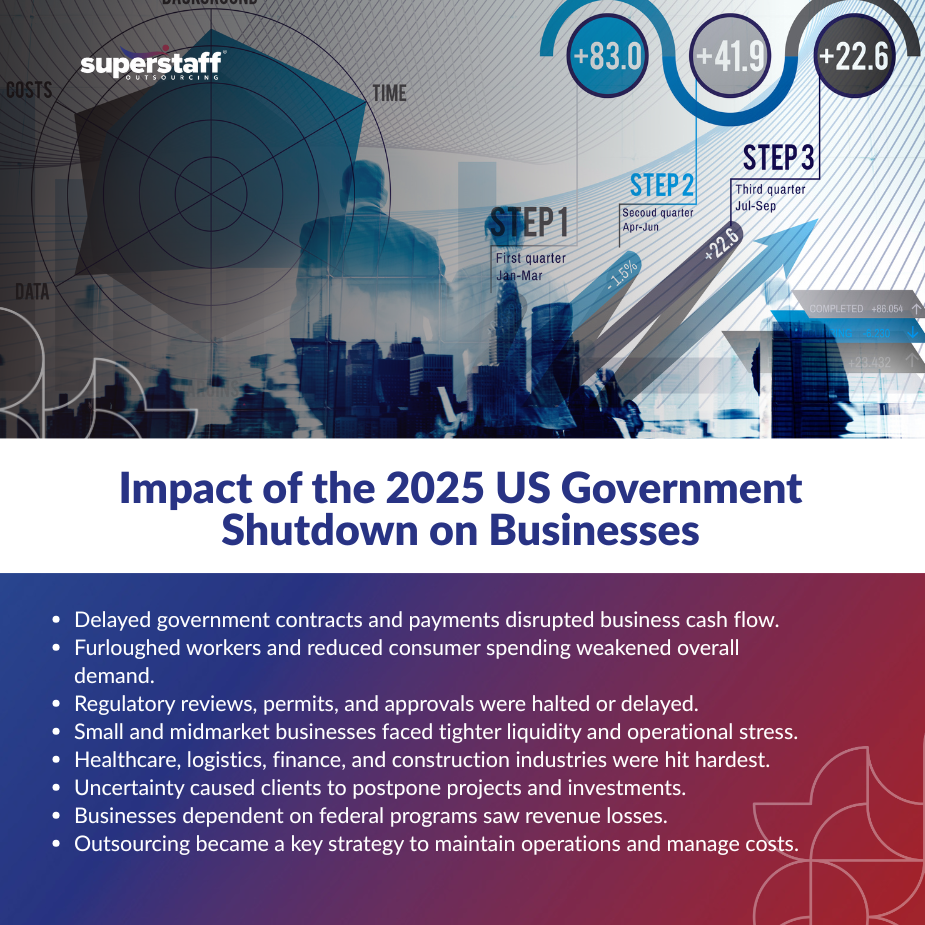
When a US government shutdown hits, the headlines often focus on furloughed federal workers and political standoffs in Washington. But beyond Capitol Hill, the ripple effects quickly spread through the private sector, touching businesses that have no direct ties to government contracts. From delayed regulatory approvals and payment bottlenecks to reduced consumer spending, even small and midmarket companies find themselves caught in the crossfire of political gridlock.
This latest shutdown is unfolding against a backdrop of mounting fiscal tension and partisan divide, with federal funding stalled and critical agencies halting operations. For businesses already navigating inflationary pressures, supply chain unpredictability, and rising operational costs, the disruption adds another layer of uncertainty to an already fragile economy.
In this blog, we’ll break down what a US government shutdown truly means for your business—whether you’re a startup, SME, or established enterprise. More importantly, we’ll explore how outsourcing can provide stability, operational continuity, and cost efficiency when domestic systems stall. By the end, you’ll gain clear, actionable strategies on how to keep your business resilient amid government standstills and economic slowdowns.
What Is a U.S. Government Shutdown — The Mechanics and Why It Happens
A US government shutdown occurs when Congress fails to pass appropriations bills or continuing resolutions (temporary funding measures) to keep federal agencies and programs funded. In practical terms, the government runs out of legal authority to spend money on non-essential operations.
Without that authorization, many services are paused, federal employees are furloughed (or required to work unpaid), and the machinery of government begins to creak under the weight of financial inertia.
How the Shutdown Mechanism Works
- Budget impasses & appropriations deadlines. The U.S. federal government operates on a fiscal year that runs from October 1 to September 30. Before the fiscal year ends, Congress must either pass 12 individual appropriations bills or a continuing resolution (CR) to extend funding while negotiations continue. If neither is passed, a funding gap occurs.
- Antideficiency Act & legal constraints. Under the Antideficiency Act, federal agencies cannot legally incur obligations or spend money in excess of appropriations. Thus, when funds lapse, non-essential services must cease, and only work that is deemed essential or life‐sustaining can continue.
- Furloughs and workforce impacts. Federal employees whose duties are classified as non-essential are furloughed without pay until a funding deal is reached. Meanwhile, some employees may continue working “without pay” if their roles are deemed essential, to protect life or property.
- Paused services and delayed functions. Many regulatory, permitting, enforcement, grant, and oversight activities may be suspended or operate with minimal staffing. This can create bottlenecks across public and private sectors.
Essential vs. Non-Essential Services
One of the key distinctions during a shutdown is between essential (or “excepted”) functions and non-essential (or “non-excepted”) operations.
- Essential services: These are services whose interruption would jeopardize public health or safety. Examples include air traffic control, border security, law enforcement, emergency services, military operations, and certain health services (e.g., continued approval of life-saving medications).
- Non-essential services: Activities that can be delayed without immediate harm to life or property fall here. Examples include many administrative operations, noncritical regulatory reviews, research funding, and many public outreach or educational programs. During a shutdown, non-essential services are halted or significantly scaled back.
Duration and Historical Precedents
Shutdowns vary in length, from a few days to over a month. Their impact tends to escalate with duration.
- Typical durations: Many shutdowns historically last only days or a week, often resolved with last-minute deals.
- Longest example: The 2018–2019 shutdown lasted 35 days (December 22, 2018 to January 25, 2019), making it the longest in U.S. history. During that time, many federal workers were furloughed or forced to work without pay.
- Recent context: The current 2025 shutdown began on October 1, 2025, when Congress failed to pass funding legislation ahead of the fiscal year deadline.
- Scale of disruption: In 2025, the shutdown resulted in over 800,000 federal employees being furloughed and many more required to work without pay.
Every shutdown becomes a test of endurance: the longer it drags on, the deeper the ripple effects into the economy.
Having defined what a US government shutdown is and how it works, let’s turn to how these funding stoppages cascade through the economy and ripple into private businesses.

Broader Economic and Business Impacts of a Shutdown
A government shutdown isn’t just a political spectacle. It sends shockwaves through the economy, affecting private firms large and small. This section explores how delays, uncertainty, and constrained spending show up in real-life business operations.
Economic Consequences & Business Fallout
- Delayed government contracts and procurement. Businesses that rely on federal contracts, grants, or procurement schedules often see work delayed or payments postponed until funding is restored.
- Reduced consumer spending. Furloughed government workers lose income (or face delayed paychecks), which depresses demand for goods and services in local and national markets.
- Interrupted regulatory oversight and approvals. Agencies that approve permits, licensing, certifications, or compliance reviews may slow or stop operations, delaying business expansions, product launches, or regulatory compliance.
- Data and forecasting disruptions: Government statistical agencies (e.g. Bureau of Labor Statistics, Census Bureau) often suspend data releases during shutdowns, depriving markets and businesses of timely economic insights.
Impact on SMBs and Midmarket Companies
Small and midmarket businesses are especially vulnerable because they tend to have tighter cash flows and fewer buffers than large corporations:
- Liquidity stress: Delays in contracts or payments may immediately strain operating capital or payroll obligations.
- Credit risk: Uncertainty or delayed payments may hamper their ability to service debt or negotiate favorable terms with suppliers.
- Vulnerability to cascading delays: Because SMBs often depend on a chain of services (e.g., permits, inspections, certifications), a pause in one regulatory or government function can derail entire projects.
Industries Particularly Affected
Some sectors feel the pinch more acutely than others:
- Healthcare / life sciences: Delays in regulatory approvals, grant funding, or reimbursements (Medicare, Medicaid) can stall drug launches, clinical trials, or reimbursement flows.
- Logistics / transportation: Border operations, customs, and transportation infrastructure rely on federal agencies (e.g. TSA, Coast Guard). Shutdowns can slow import/export processing or inspections.
- Financial services: Regulatory bodies like the SEC, CFTC, and others may furlough staff, delaying filings, IPOs, or oversight, as recently reported.
- Construction / infrastructure: Permits, environmental reviews, and federal oversight (e.g. via the EPA or Department of Transportation) may be delayed, pushing back large public or hybrid projects.
The high-level economic effects are severe, but for most business leaders, the tangible risks come through operational disruptions. Let’s dig into those.
Operational Risks Business Leaders Must Face During a Shutdown
When federal systems slow or idle out, companies feel it in their day-to-day operations. Here’s a breakdown of the kinds of risks that surface—and how deeply they can bite.
Revenue Loss & Interrupted Business Streams
- Loss of federally tied revenue: If part of your business depends on servicing government contracts or working as a subcontractor to federal initiatives, those revenue streams can stall.
- Delayed grant funding or subsidy programs: Many businesses (especially in R&D, clean energy, or education) depend on matching grants or subsidies that may pause.
- Client uncertainty and cancellations: Clients may postpone decisions or projects tied to public sector timelines, leading to cancellations or demand contraction.
Compliance, Permits & HR Uncertainty
- Delayed visas, licenses, and permits: Businesses that rely on federal agencies for immigration, transport, or trade permits may face lengthy bottlenecks.
- Regulatory review backlogs: Compliance, audits, environmental reviews, or certification processes could slow or freeze entirely.
- HR and benefits uncertainty: Federal employees and contractors may face pay delays or furloughs — companies that co-employ or support services to them may face knock-on HR challenges.
- Uncertain liability exposure: If your business carries work requiring government oversight, lapses in regulatory supervision may increase regulatory risk or liability.
Payment Delays in the Contractor Ecosystem
- Slow contractor pay: Federal contractors and subcontractors may see delayed invoicing and payments, especially for work already performed but awaiting clearance.
- Cash flow pressure downstream: Subcontractors, suppliers, and vendors further down the chain may get squeezed as money moves slower.
- Credit exposure: Larger contractors may default or delay payments to smaller suppliers if their own cash flow tightens.
With those operational pain points laid bare, it becomes clear that one powerful buffer against shutdown volatility is outsourcing. Let’s examine how.
Why Outsourcing Can Bolster Business Resilience During a US Government Shutdown
In a crisis of funding freeze and institutional stalling, outsourcing emerges as a strategic lever for continuity. Outsourcing can help bridge gaps, insulate core operations, and maintain essential business momentum even when federal systems lag.
Continuity in Back-Office Functions
- Accounting, payroll, bookkeeping: These functions can be outsourced to teams operating outside the U.S. or on independent funding cycles, ensuring payroll, billing, and reconciliation continue uninterrupted.
- Administrative and data processing: Routine data entry, document processing, record reconciliation—these can run smoothly with offshore or nearshore teams.
- IT operations and infrastructure: Outsourced IT support, cloud administration, and monitoring can avoid internal staff resource constraints during turmoil.
Customer Experience (CX) Outsourcing
- Helpdesk, customer support, chat & voice support: Even if funding-related business slows, maintaining customer relationships is crucial. Outsourced CX teams can keep communication alive.
- Proactive customer engagement: Outsourcers can manage outreach, status updates, and reassurance messaging while your internal team focuses on contingency planning.
- Multilingual support & expansion: Outsourced CX enables scaling support in new markets or handling overflow without relying on local staffing.
Flexible Staffing & Talent Buffering
- On-demand talent scaling: Outsourcing offers the ability to scale staff up or down quickly depending on demand fluctuations, without long-term fixed costs.
- Skill augmentation: Access talent with specialized skills (e.g. compliance, regulatory insight, legal outsourcing) that may be harder to maintain in-house under budget stress.
- Geographic diversification: With teams distributed across regions or countries, your operations can ride out localized disruptions or regulatory slowdowns inside the U.S.
By moving non-strategic or support functions into outsourcing arrangements, your internal team remains focused on core value delivery, while the outsourced backbone helps you weather external shocks.
Outsourcing offers resilience during a US government shutdown, but companies also need financial and structural strategies to manage risk. Next, we’ll look at cost and risk management tactics you should consider.
Cost Management & Risk Mitigation Strategies
With tightening budgets during a government shutdown update, taking a proactive approach to cost structure and risk positioning is essential. Below are strategies for leveraging outsourcing to keep your business agile and protected.
Variable Cost Models & Pay-As-You-Go Outsourcing
- Avoid fixed overheads: Instead of hiring full-time staff for functions that may be underutilized during a shutdown, use outsourcing models where you pay only for actual usage (e.g. per hour, per transaction).
- Scalable service tiers: Negotiate contracts with tiered service levels, enabling you to scale down during slower periods without paying for capacity you don’t need.
- Flexible contracts: Favor contracts with low minimum commitments and penalty-free scaling flexibility to adapt to uncertain cycles.
Risk Diversification via Offshore / Nearshore Partnerships
- Geographic diversification: Partner with providers in multiple regions (e.g., Southeast Asia, Latin America) so local regulatory or economic shocks don’t paralyze your entire operations.
- Vendor redundancy and backup providers: Maintain relationships with multiple outsourcing partners so you can switch or ramp quickly if one provider becomes compromised by external disruptions.
- Regulatory and data compliance planning: Ensure your outsourcing agreements include provisions for data security, legal compliance across jurisdictions, and business continuity clauses in case one location is impacted.
Financial Safeguards & Cash Buffering
- Maintain cash reserves: In anticipation of delayed payments or contract uncertainty, hold a buffer of three to six months of operating liquidity.
- Invoice structuring and advance payments: Where possible, negotiate partial upfront payments or milestone payments to lessen exposure to final-payment delays.
- Credit and insurance instruments: Explore invoice factoring, supply chain financing, or credit lines that can be triggered during a shutdown scenario.
By treating outsourcing not just as a cost play but as a risk hedging tool, you can insulate your business from fluctuations tied to federal funding cycles.
With operational buffers and cost strategies in place, the final piece is embedding resilience into your long-term strategic posture.
Strategic Lessons and Long-Term Takeaways From US Government Shutdown Risks
Shutdowns tend to repeat themselves over time. Rather than merely reacting each time, businesses can build structural resilience. Here are strategic principles and best practices to embed.
Building a Flexible, Global Team
- Distributed workforce model: Recruit and maintain core and support teams across different geographies so no one region’s disruption derails your entire operation.
- Cross-training and role redundancy: Encourage role interchangeability and cross-training so functions can shift in case of regional constraints or staff absences.
- Decentralized decision-making: Empower regional or divisional autonomy so that disruptions in centralized U.S. governance don’t stall all decision flow.
Investing in Crisis-Proof Workflows
- Automation and standardization: Automate routine tasks (billing, reporting, reviews) so fewer manual dependencies stutter under pressure.
- Modular process design: Design workflows to run in disconnected or fallback modes—if a regulatory step stalls, operations downstream can still proceed in a “safe mode.”
- Scenario planning & playbooks: Maintain “shutdown playbooks” or contingency protocols for varying durations—so teams know what to prioritize when delays hit.
Embedding Outsourcing Into Business Continuity Plans (BCP)
- Outsourcing as a core pillar, not add-on: Treat third-party providers as integral parts of your BCP, with remediation protocols, fallback teams, and redundancy baked in.
- Regular testing and drills: Conduct periodic simulations of funding-freeze scenarios to validate that outsourced partners can sustain operations under duress.
- Continuous partner evaluation: Regularly assess outsourcing providers for resilience, capacity, geopolitical risk, and compliance readiness.
By adopting these long-term approaches, your business doesn’t just survive the next US government shutdown — it becomes more agile, responsive, and insulated from systemic uncertainty.
Now, let’s draw these ideas together with a concluding view.
Mitigate the Effects of the US Government Shutdown With the Right BPO Partner
Shutdowns of the U.S. government underscore not only political tension but deeper structural vulnerabilities in how businesses interact with public institutions. But the story need not be one of helplessness.
Here’s what the US government shutdown means for small businesses: It can introduce sudden disruptions, such as delays in contracts, regulatory hold-ups, and revenue volatility, but it also highlights the value of adaptability.
This blog explored what a shutdown is, how it ripples across the economy, the operational risks it imposes, and how outsourcing can act as a stabilizing lever. From cost strategies to long-term resilience planning, outsourcing offers a concrete pathway to absorb volatility rather than succumb to it.
If you’re a decision-maker evaluating how to bolster your firm’s resilience, now is the time to rethink how critical functions are furnished. Partner with outsourcing providers like SuperStaff to build a flexible backbone that supports continuity through any external shock.
Reach out today to explore how your operations can stay stable in the face of inevitable uncertainties—including the next government funding impasse.






